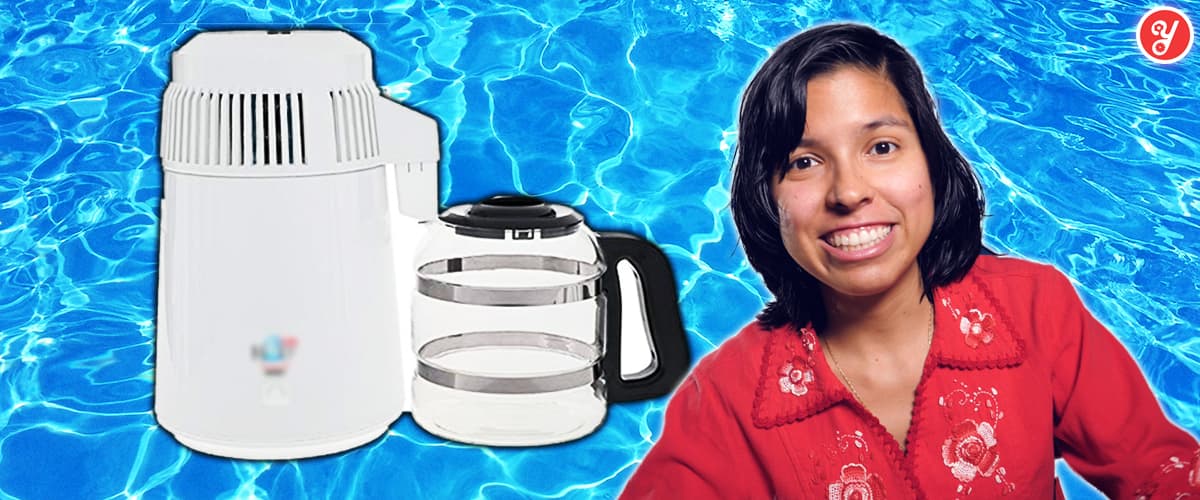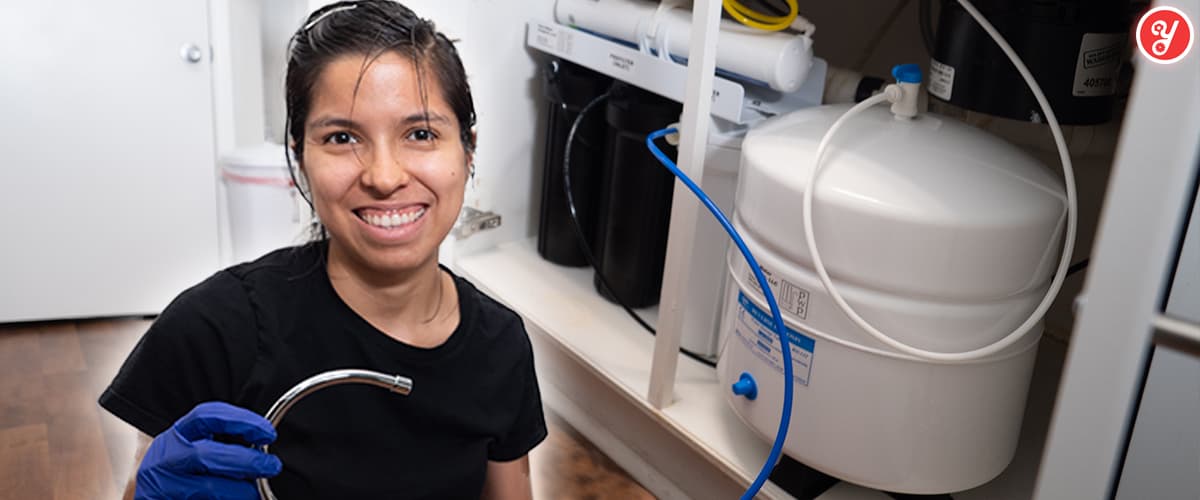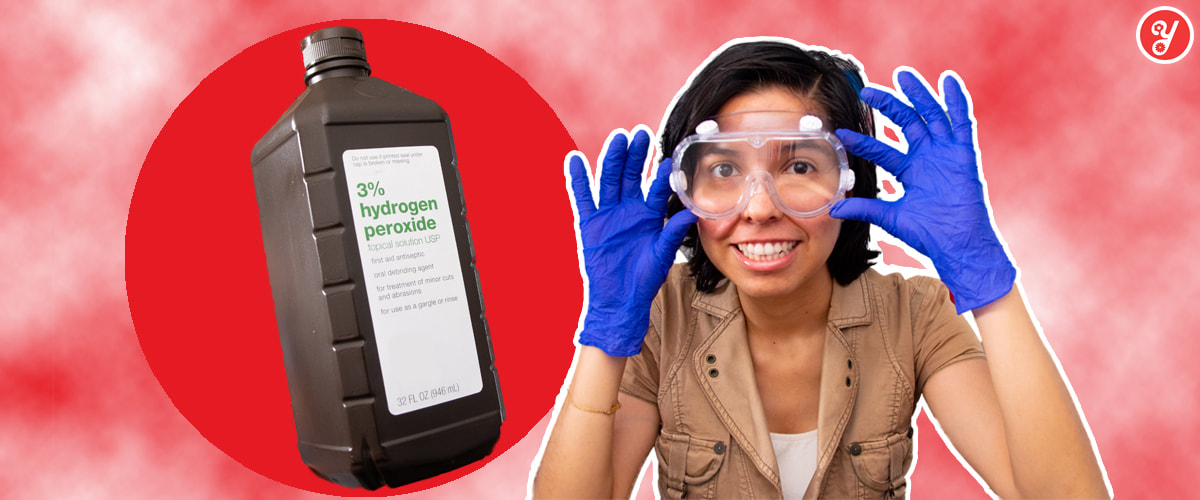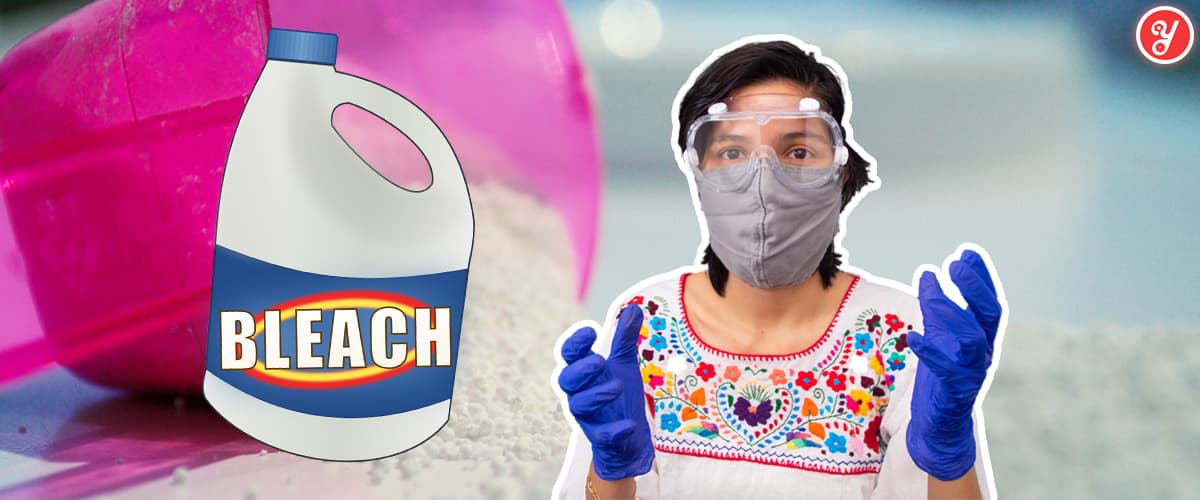Yoguely is reader-supported. When you buy through links on our site, we may earn an affiliate commission. Learn more
Reverse Osmosis Water Filter System: The Definitive Guide
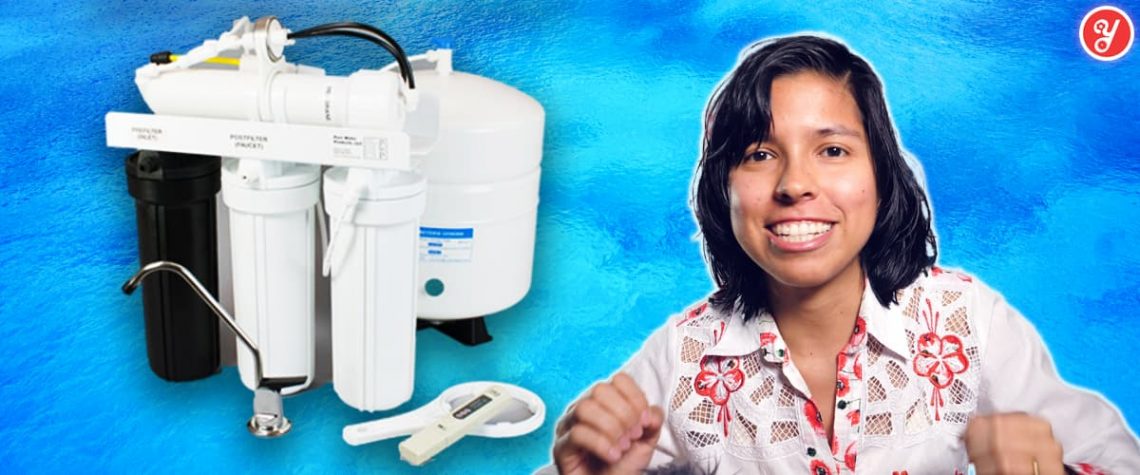
Today I will teach you everything you need to know about reverse osmosis. So that you can configure the ULTIMATE purified water filter system setup and easily make healthy drinking water right at home.
If you are serious about drinking the PUREST water that is 99% free from impurities that are harmful for your health.
AND you want a system that is super convenient to use with hassle-free maintenance. Then this post is for you.
This is the fifth part of my complete guide to healthy drinking water.
I’m your host Aida Yoguely. Let’s begin.
How Reverse Osmosis Works
First I’ll explain how reverse osmosis works and what it does. Reverse osmosis filters fluids by using water pressure to push tap water through a partially permeable membrane.
This semi-permeable membrane has super tiny pores about 1 nanometer or even smaller in size.[55], [56] A nanometer is 10-9 m, which is so small, it only allows the solvent molecules to pass. In our case, just water, pure H20.
The solutes, which are the substances dissolved in the water, are too large to pass through the membrane pores. Therefore, the membrane filters them out.
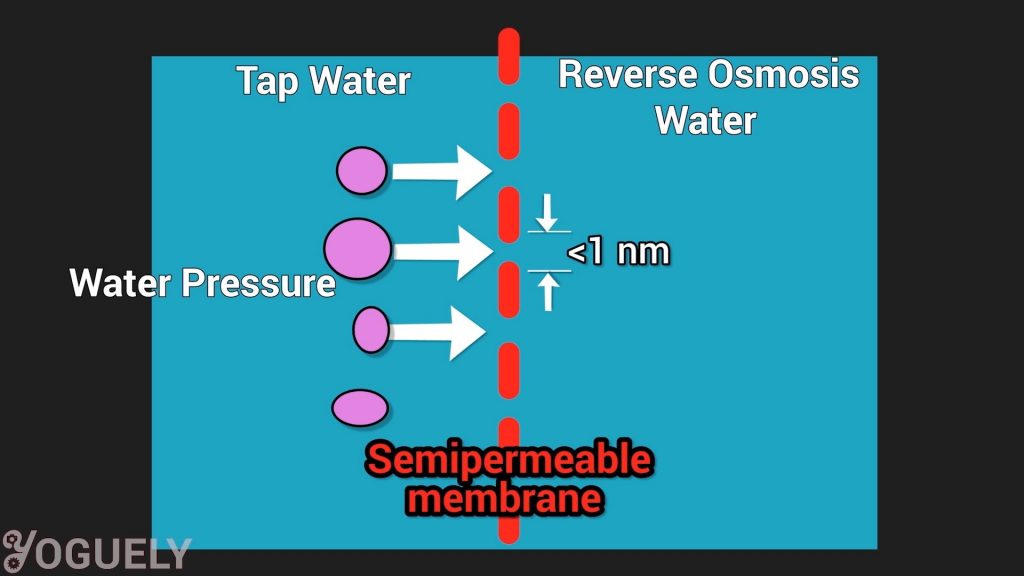
What Kinds of Substances Does Reverse Osmosis Remove?
Reverse osmosis removes all minerals, cysts, coloring, turbidity, and organic and inorganic chemical contaminants.[16] In fact, RO is highly effective in removing bacteria and viruses.[57] This includes the coronavirus during the current COVID-19 pandemic.
Any unwanted ions and molecules that the membrane filters, go out in to the drain.
That’s right! RO systems do not require daily maintenance. With a Reverse osmosis unit, you don’t have to do any scrubbing to dispose of the impurities. (compared to a distillation system)
Instead the pressure pushes the pollutants automatically out the drain tube and into your drain pipe. Or you can collect that water for other purposes — like flushing your toilet.
Why Do We Call It Reverse Osmosis?
We call it reverse osmosis because its opposite than what wants to happens in nature. Solvents naturally want to move from a place of low solute concentration to an area of high solute concentration. This continues until the concentration is the same on either side. This is the natural process of osmosis.
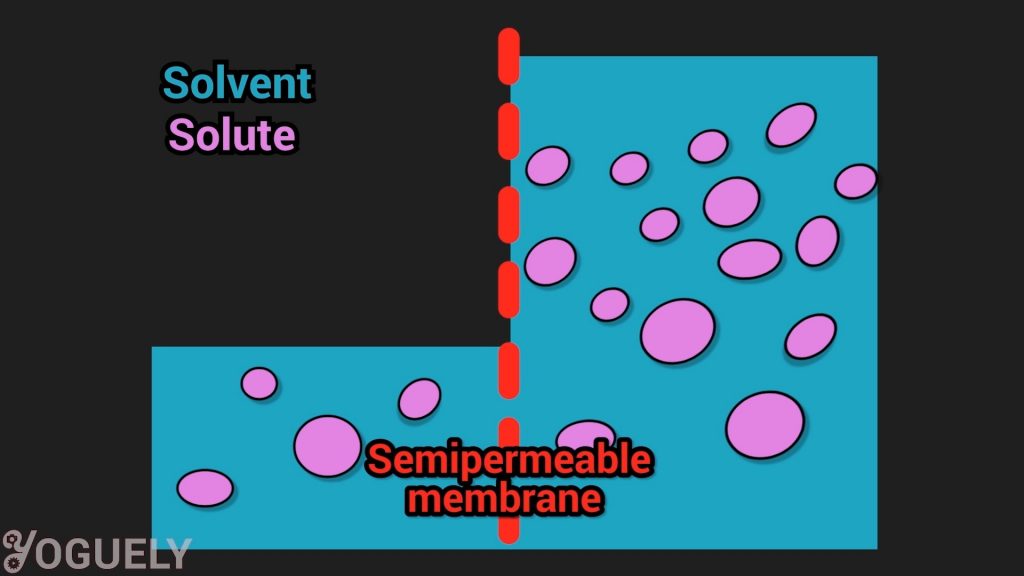
But what if you manually put energy into the system?
Apply water pressure in the reverse direction and you can overcome the natural tendency of osmosis. Push the solvent water from a place of high solute concentration to an area of low solute concentration. Now you’ve done reverse osmosis. It’s the principle behind how the RO system works.
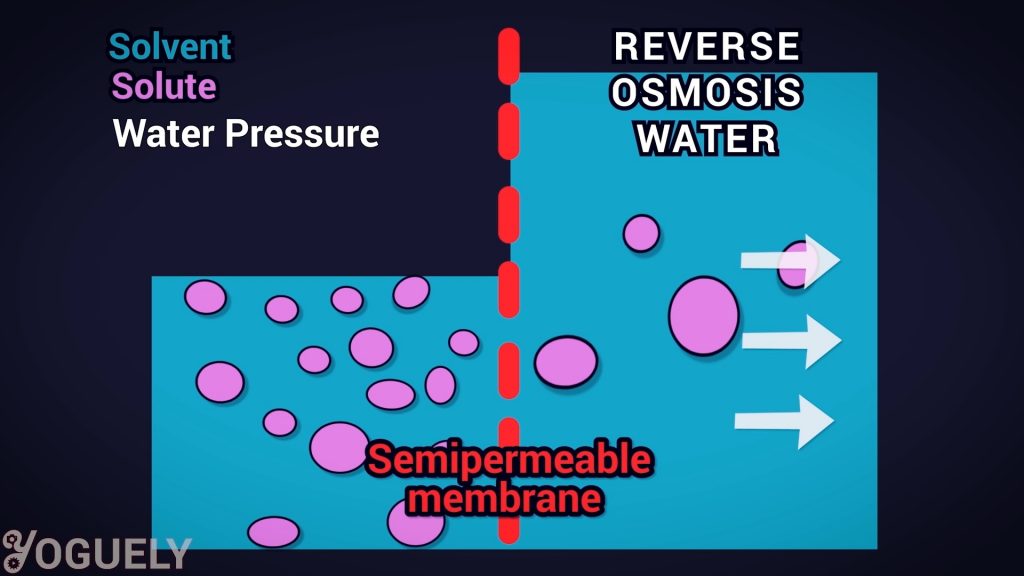
How Much Energy Does Reverse Osmosis Require?
Reverse osmosis does not require any power to function. It works solely with water pressure. As a result, there are no electrical hazards or electricity costs to using a reverse osmosis system.
What Does Reverse Osmosis NOT Remove?
Reverse osmosis is not effective to remove Volatile Organic Contaminants (VOCs) and pesticides. So, to make an efficient RO filtration system, you’ll need to add an activated carbon filter.
Reverse Osmosis Systems Needs an Activated Carbon Filter
The first reason is because activated carbon is the best, and sometimes the only treatment the health organizations recommends to remove Volatile Organic Contaminants (VOCs) and pesticides.
The second reason is because if you were to pass water solely through a RO membrane, the RO membrane would get worn out pretty quickly. The tiny pores would catch everything, large and small, and plug up fast.
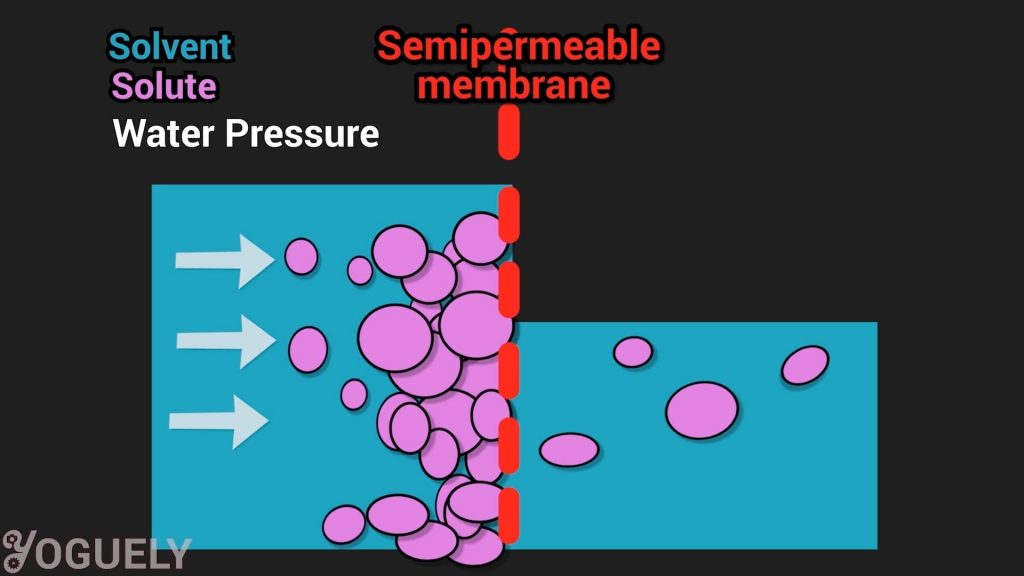
So, to extend the life of the membrane, it’s beneficial to use a pre-filter. Carbon filters can have a nominal pore size of 1 micron. That is 1000 times bigger than a RO membrane. This makes carbon filters a good fit to have as a pre-filter.
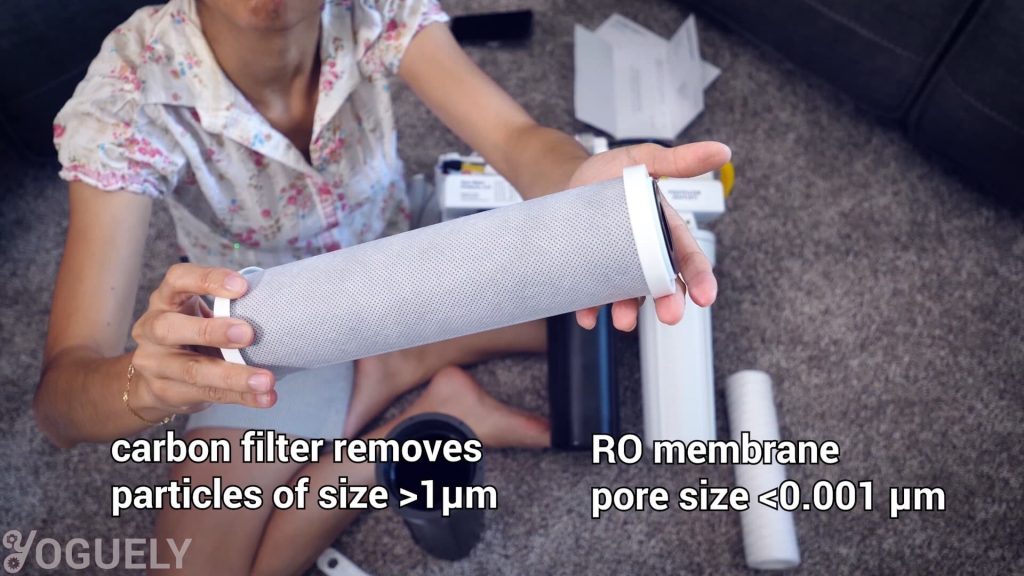
For these two reasons, activated carbon is essential for reverse osmosis systems.[58]
In case the pre-filter happens to miss any contaminants, RO systems also use activated carbon as the final stage post-filter. Which can be considered redundant, but it ensures that taste and odor is improved.[59]
Maintenance-wise, you’ll need to replace both pre- and post- activated carbon filter cartridges annually. A new set can cost about $37.[60]
On a side note, you can think of a simple faucet mount (paid link) filter, or even a water bottle with filter (paid link) as a 1 stage filtration system. The one and only stage being a carbon filter (paid link).
Remove Dirt, Sand, and Large Particles with a Sediment Pre-Filter
Have you noticed any sand or dirt in your water? Any particles floating around and particles settling at the bottom?
If you do, then you will need a sediment pre-filter.
A sediment filter will remove over 85% of particles of size 5μm or larger. Comparatively, the size of sediment particles are five times bigger than the pores in carbon filters. [61]
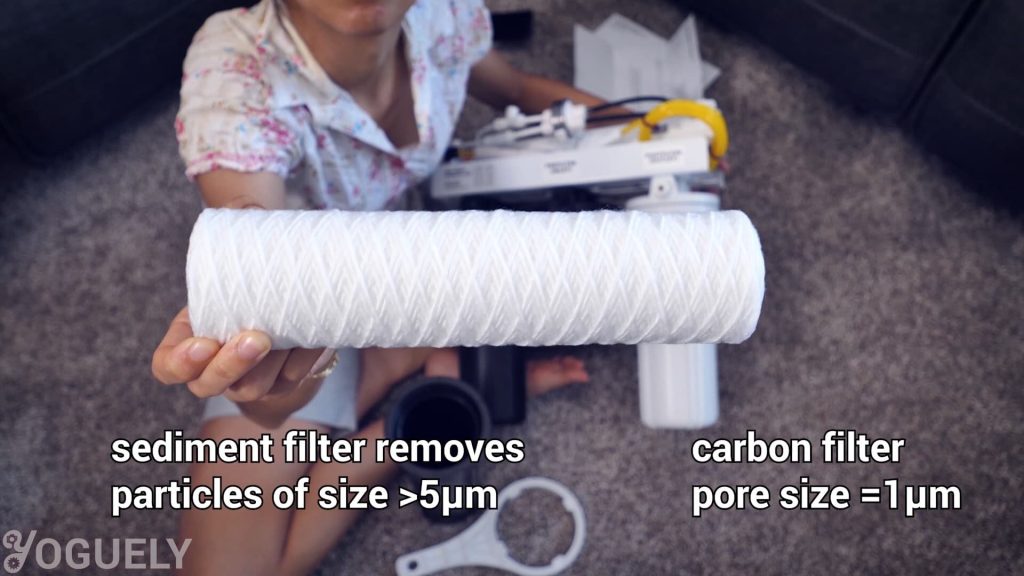
Those large visible particles would wear out the carbon pre-filter pretty quickly. Most city water won’t have this problem. But if you do, then you will need a sediment pre-filter before the activated carbon pre-filter.
I won’t have that problem since I get municipal water. But I would like to have an extra filter cartridge housing just to have the flexibility of having additional pre-filters in the future.
If you use a sediment filter, you’ll need to replace it yearly. But fortunately, they are probably the cheapest of any kind of filter you can get. They cost around $16 each.[62]
You can see the trend in price here. The smaller the particle size we wish to remove, the higher the cost to filter it out.
Differences Between Reverse Osmosis Membranes
There are different kinds of Reverse osmosis membranes. The technical difference is how much total dissolved solids (TDS) the membranes filter out and how much water is wasted in the process.
For instance, a 24gpd Filmtec Membrane will filter out 98% of TDS but waste 4 cups of water for every cup of purified water produced. Hence having a 4:1 waste ratio.
In the other hand a 50gpd Pentek GRO Membrane will filter out 96% TDS and only waste 1 cup of water for every cup produced. Thus, having a better 1:1 waste ratio.[63]
Which GPD Flow Rate Is Best?
The flow rate which is measured in gallons per day (GPD) also differs among the two. A 50 gpd membrane has a higher flow rate than a 24 gpd membrane. But if you are using a water storage tank, then you won’t notice the difference in flow.
How Do 96% TDS vs 98% TDS Removal Compare?
Recall earlier in the blog, when I tested my tap water, it had a reading of 98 ppm.
If I have a 96% TDS removal, that would leave only 4 ppm in my purified water. On the other hand, a 98% TDS would leave about 2 ppm. Which is INSANELY soft water considering that the EPA recommends, but does not enforce, a max TDS level of 500 ppm.[8]
Among the two membranes mentioned, the difference in water savings is astounding compared to the almost negligible difference in purity.
So, it depends on what you are willing trade off. A higher water bill today or, depending on your water quality, a potentially higher medical bill in the future.
I’m going to take a chance and start out with the 1:1 efficiency RO membrane. Perhaps I’ll experiment with other membranes in the future.
Maintenance of Reverse Osmosis Membranes
Say you are using a sediment pre-filter as necessary, and have an activated carbon pre-filter in place. In that situation, a reverse osmosis membrane should last about 3 to 5 years before needing a replacement.
You can tell when the membrane needs replacement when you see a noticeable change in your TDS reading.
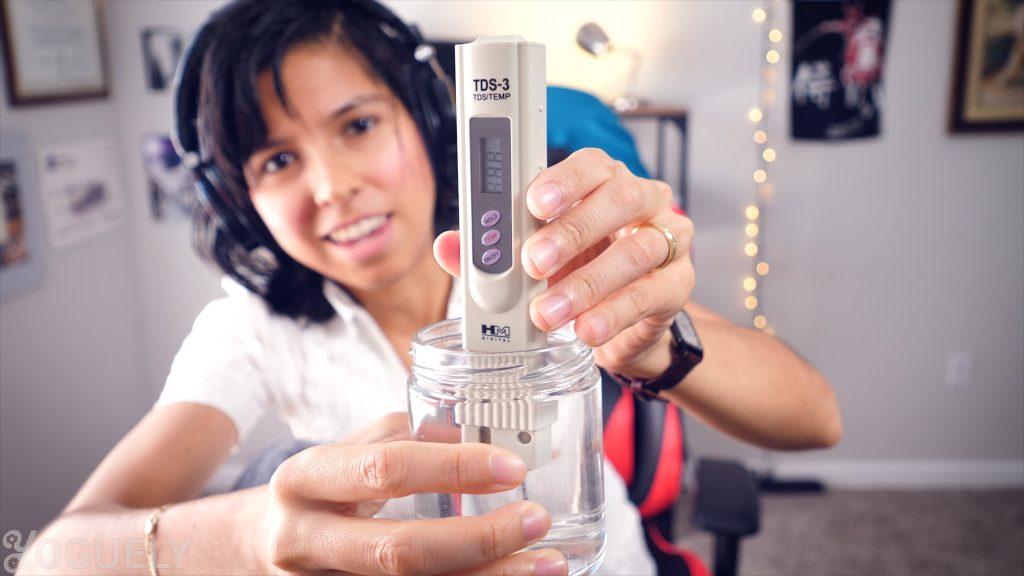
Other than that, you may need to lubricate the O-Rings in the vessels with Silicone Grease when replacing the membrane cartridge.
The cost for a RO membrane with 1:1 ratio is about $75,[64] which would equate to spending about $25 per year. Say you wish to decrease this yearly cost but spend more your water bill with the 4:1 ratio RO membrane that costs $54 each. The yearly expense would be $18 per year.[65]
Consider that most people do not need a sediment filter ($16/year). The yearly recurring maintenance for a RO system with a carbon pre- and post-filter ($37/year), and the cheaper RO membrane ($54/3 years), would be about $55/year total annual maintenance cost.
I’m definitely attracted to the idea of just setting it up and never having to touch the system. Except to replace the filters once a year. I want to set as many routine aspects in my life on automatic. That way I can have more free time for more creative endeavors.
Under-Sink vs Countertop Reverse Osmosis Water Filters
There are essentially two configurations for an in-home RO system. You can get a compact countertop option, which as the name suggests, sits on top of your kitchen cabinet.
The countertop RO has a compact design, so for space-saving purposes it does not have a water tank. [66] The water tank is useful for storing already filtered water. This is because the RO filter can only flow so much water through the membrane at a time. The low pressure makes the flow straight out of the membrane very weak.
Do you have the mighty strong patience to leave a water bottle filling up while you multitask nearby? If so, then this countertop option could be an option for you.
For about twice the cost, another configuration is an under-sink option. It is bulkier but it includes a water storage tank. [63] With a water tank, you can store filtered water so its readily available when you need it. As a consequence, you’ll get higher pressure and faster flow whenever you open the faucet.
This under-sink configuration is not that much harder to install or to maintain. For this reason, I think the under-sink configuration is the most convenient option in the long run. Time is money after all.
How Much Does It Cost to Install a Reverse Osmosis System?
Professional plumbers can charge a very hefty fee to install an under-sink or countertop RO option. Basically, whatever they can get away with.
Most reverse osmosis systems are actually pre-built, requiring little assembly which makes it ridiculously easy to install for free.
At first glance the installation can look complicated but if another human can do it, so can you.
Save the headache of hiring someone else’s time and use a fraction of what that would have cost to get any common household tools you need to install it.
It pays off to do it yourself. You acquired a new skill. You feel proud of yourself. And you feel satisfied that you can troubleshoot issues in the future.
My principle to save money in the long run is the following. If you are going to own something, then you must be willing to take on all responsibility for it, ideally without passing it on to others.
The exception would be if you are financially independent and can afford the luxury. Or if you can use that time to make more money than you would have spent having someone else do it.
If you are feeling uncomfortable with the installation and maintenance, have no fear, Aida’s here! In my next post, I’ll walk you through step by step through the RO installation process.
Have Zero TDS Water with a De-Ionizing Filter Cartridge
Say you are not satisfied with a reverse osmosis that only removes 98% TDS. You want perfection. You are looking to bump it up to the MAXIMUM level of 100% TDS removal. Then a de-ionizing (DI) filter cartridge is what you need to get that ultra-pure zero TDS water.
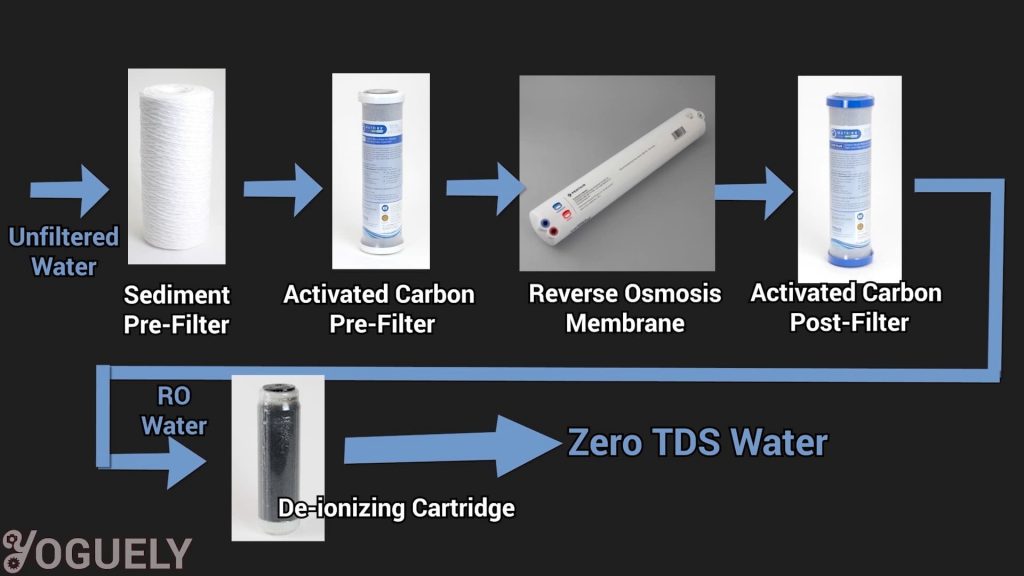
The idea is to deionize the water. That means to remove all remaining dissolved ionized solids. You can achieve this by swapping any positively charged ions with hydrogen ions (H+), and switching negatively charged ions with hydroxyl ions (OH–).[67] When that replacement happens, it creates a new water (H2O) molecule.
The de-ionizing filter contains a mixed bed resin consisting of two ion-exchange resins in the same cartridge. When the reverse osmosis water passes through the DI filter, all that is left is pure water with zero TDS.
If a de-ionizing (DI) filter is used in combination with a reverse osmosis system, then the DI filter can last up to a year before you need to replace it. Replacement runs for about $29 per DI cartridge.[68]
Is zero TDS water necessary?
It is certainly the best you can do to be sure you are drinking nothing but pure H2O. But I wouldn’t stress over it if it is outside of your budget.
Isn’t it ridiculous that you even have to pay more money to drink toxin-free water?
The better thing you can do, regardless of which ever industry you are in, is to be environmentally conscious. Please make decisions that do not pollute the water in the first place. Thanks in advanced.
Re-mineralize and Balance pH of Purified Water with Calcium
As you can see, with a reverse osmosis filtration system you can’t pick and choose what stays and what goes. Oh! This mineral good let’s keep it, oh that one’s toxic let’s filter that out.
Ideally, I would want H20 plus the good minerals minus the harmful ones.
A reverse osmosis system basically filters out anything larger than a water molecule. But what you can do, is selectively reintroduce a mineral you wish to add to the water.
Say you could reintroduce any single mineral you want, and make healthy drinking water with added minerals. Which would that be?
A good choice could be calcium. You can remineralize water with calcium using a calcite cartridge. Calcium by the way is an essential nutrient for many of our body functions: from our blood, to our muscles, bones, and teeth.[3] It also gives water a pleasant taste.
Calcite is a form of calcium carbonate (CaCO3). But the most efficient way for our bodies to absorb calcium carbonate is actually by taking it with food.[69]
People that take calcium carbonate supplements tend to experience gastrointestinal side effects. Especially those who don’t spread it out with meals.
Since we can consume most of the calcium we need from foods anyways,[3] I would not consider the nutritional benefit as a huge reason to get a calcite cartridge.
So, what else can you use calcite for in water treatment?
Another effect of adding calcium to water is that calcium raises the pH of reverse osmosis water. The pH increases from slightly acidic to a neutral pH of 7.0 (at room temperature 25 °C).
Wait, hold on.
Why Purified Water Does Not Have a Perfectly Neutral pH?
In theory yes, isolated purified water does have a 7.0 pH, but science isn’t so straightforward. There is more going on that tips the scale of slightly acidic. For this we need to dive into what a pH scale is telling us.
Let’s look at the case of purified water. Neutral pH occurs when the concentration of hydrogen ions (H+) equals the concentration of hydroxyl ions (OH–).
[H+] = [OH–]
Now zoom in to see what molecules of water H2O are up to. They are constantly separating into forms like H+, OH–, and H3O+ and then bonding into water again.
If there were more free H+ ions, then the water would be more acidic. But if we added OH– then that would combine with the free H+, making the water neutral again.
Now what happens when you expose purified water to air?
The water molecules will absorb a carbon dioxide molecule. Instantly, they react to form bicarbonate and a hydrogen ion, which is equivalent to carbonic acid.
CO2 + H2O ⥨ HCO3– + H+ = H2CO3
Hence purified water tends to have an acidic pH scale reading when exposed to air. [70]–[72]
On a side note, this is also related to the reason why we say it’s raining acid rain. The rain that falls comes in contact with pollutants in the air and becomes acidic.
Which brings us back to the calcite cartridge. Flow purified water through it to balance the pH level from mildly acidic to neutral 7.0. Which is why a calcite cartridge is sometimes called a pH filter or an alkaline remineralization filter. By the way, a calcite cartridge costs around $22 to replace.[73]
After better understanding pH levels, it makes me wonder:
What Is the Best pH for Healthy Drinking Water, Alkaline or Acidic?
The Environmental Protection Agency (EPA) recommends, but does not enforce, a pH level of 6.5 to 8.5.[8] They wrote this guideline mainly to avoid people from drinking water that tastes or smell bad. Which could eventually lead you to stop drinking public water at all.
Important to realize that pH level is telling us the relative concentration of acids to bases in a solution. Therefore, it is not a clear indicator of whether the water quality is good or bad for your health.
Drinking slightly acidic or even basic water, also known as Alkaline water, could be fine for you. But that would really depend on the chemistry of the water, exactly what compounds are in it.
After learning all this, I personally would not get a calcite cartridge for my first RO system configuration. It does not seem to be a big necessity and it adds to the cost and complexity of the unit.
Filters for Other Water Problems
There is a myriad of contamination problems water can have[74] and there are many kinds of filters that can make it easier to remove certain toxins.
For example, if you have elevated levels of arsenic in your tap water, you could consider getting a filox cartridge.
First off, a basic RO system with carbon filters is already very effective in removing certain kinds of arsenic. But you can make it easier to remove other kinds of arsenic if you pre-treat the water through a filox cartridge. Pre-treating will oxidize the remaining forms of arsenic so that the RO membrane can remove it more effectively.
The downside to adding a filox cartridge is that it significantly slows down the water flow. The filox cartridge is so dense that it could even bring the water flow to a halt. Plus, it might last less than a year and costs around $32 to replace.[75]
What Is the Best Reverse Osmosis System for the Home?
Keep it simple. The best reverse osmosis system will include at a minimum 3 filtration stages: a reverse osmosis membrane, and activated carbon pre- and post-filters.
Out in the market you’ll find reverse osmosis systems with anywhere from 2 to even 7 filtration stages. For example, this is a popular and decently priced 6-Stage RO system (paid link).
And more doesn’t necessarily mean better, but it does mean more money, more time, more space, and more complicated maintenance.
In most cases, in reverse osmosis is better for you than drinking unknown pollutants in tap water.
However, before going all out on the most complex looking RO system, check your local water treatment plant’s Consumer Confidence Report (CCR) to determine your water quality and then move forward with buying what you need.
How I will Purify Water at Home
OK after all this work, after everything I’ve learned so far, I’ve made a decision. I’ve decided to upgrade to a reverse osmosis system!
I’m going to install it. With unwavering diligence, I’m going to power through every step, until I solve this next problem.
Because that is what engineers do. And that is how we do things at Yoguely.
To stay tuned, join our newsletter and get the latest content straight to your inbox.
And tell me, what water treatment process are you using? and How is it working for you?
Technology is always evolving and so is my knowledge, so if I implement a different better solution, I’ll keep you updated.
If you have any questions, let me know in the comments below. Or join the discussion in the Yoguely Community Forum.
I’m Aida Yoguely. Thanks for learning with me today. And I’ll see you next time. That’s all folks!
Video
Be sure to subscribe and hit the notification bell to stay tuned for the latest videos.
References
3. ^ “Calcium: Fact Sheet for Health Professionals”. National Institutes of Health. (2019, July 9). Retrieved 12 September 2019.
8. ^ “Secondary Drinking Water Standards: for Nuisance Chemicals”. United States Environmental Protection Agency. Retrieved 12 September 2019.
16. ^ “Water Health Series – Bottled Water Basics”. United States Environmental Protection Agency. (2005, September). Retrieved 12 September 2019.
55. ^ “What Does a Top-Quality Reverse Osmosis System Remove from Tap Water?”. Pure Water Products, LLC. Retrieved 12 September 2019.
56. ^ “Reverse osmosis” Wikipedia. Retrieved 12 September 2019.
57. ^ “A Guide to Drinking Water Treatment Technologies for Household Use”. Centers for Disease Control and Prevention. Retrieved 12 September 2019.
58. ^ Franks, G. “Carbon Filtration: What It Does, What It Doesn’t” Pure Water Products, LLC. Retrieved 12 September 2019.
59. ^ “Understanding Reverse Osmosis (RO) – How RO Systems Work and What They Do”. ESP Water Products. Retrieved 12 September 2019.
60. ^ “Standard Cartridge Refill Pack for Black and White 3 stage RO unit”. Pure Water Products, LLC. Retrieved 12 September 2019.
61. ^ “Sediment Filters: Which is Best?”. Pure Water Products, LLC. Retrieved 12 September 2019.
62. ^ “5 Micron String Wound Sediment”. Pure Water Products, LLC. Retrieved 12 September 2019.
63. ^ “Black & White Series Reverse Osmosis”. Pure Water Products, LLC. Retrieved 12 September 2019.
64. ^ “50 GPD – Pentair GRO-50EN Encapsulated Membrane w/ Quick Connect Fittings” Pure Water Products, LLC. Retrieved 12 September 2019.
65. ^ “24 GPD TFC Membrane”. Pure Water Products, LLC. Retrieved 12 September 2019.
66. ^ “Countertop Reverse Osmosis”. Pure Water Products, LLC. Retrieved 12 September 2019.
67. ^ “How To Deionize Water”. Pure Water Products, LLC. Retrieved 12 September 2019.
68. ^ “De-ionizing Cartridge”. Pure Water Products, LLC. Retrieved 12 September 2019.
69. ^ Straub, D. A. (2007). Calcium supplementation in clinical practice: a review of forms, doses, and indications. Nutrition in Clinical Practice, 22(3), 286-296.
70. ^ Casiday, R. & Frey, R. (1998). “Acid Rain – Inorganic Reactions Experiment”. Washington University. Retrieved 12 September 2019.
71. ^ “Understanding The pH Measurement of Purified Water”. Pure Water Systems. Retrieved 12 September 2019.
72. ^ “pH”. Wikipedia. Retrieved 12 September 2019.
73. ^ “Calcite Cartridge”. Pure Water Products, LLC. Retrieved 12 September 2019.
74. ^ “Water Treatment Issues”. Pure Water Products, LLC. Retrieved 12 September 2019.
75. ^ “Filox Cartridge”. Pure Water Products, LLC. Retrieved 12 September 2019.
76. ^ National Research Council, & Safe Drinking Water Committee. (1980). “The Contribution of Drinking Water to Mineral Nutrition in Humans”. In Drinking Water and Health Volume 3. National Academies Press (US).
- Why Helicopter Money Is Inflationary - 2021-10-09
- How Interest Rates Affect Inflation - 2021-10-08
- How Long Has Inflation Existed? - 2021-10-01
